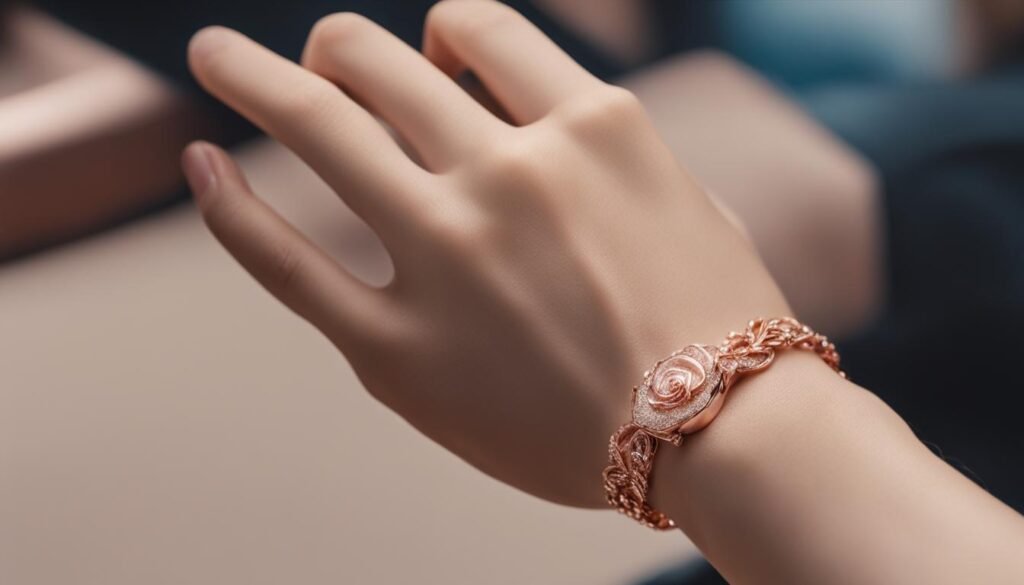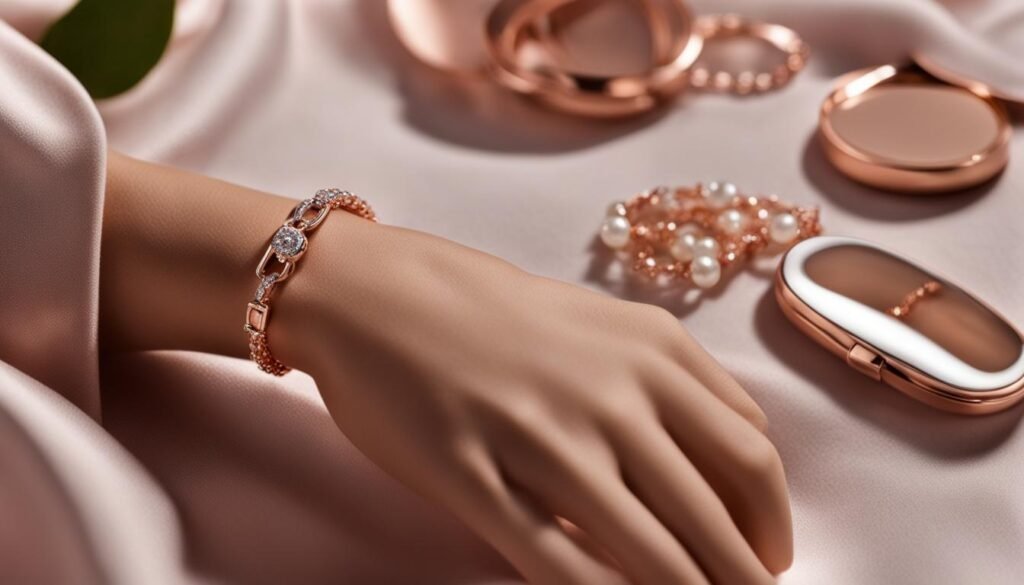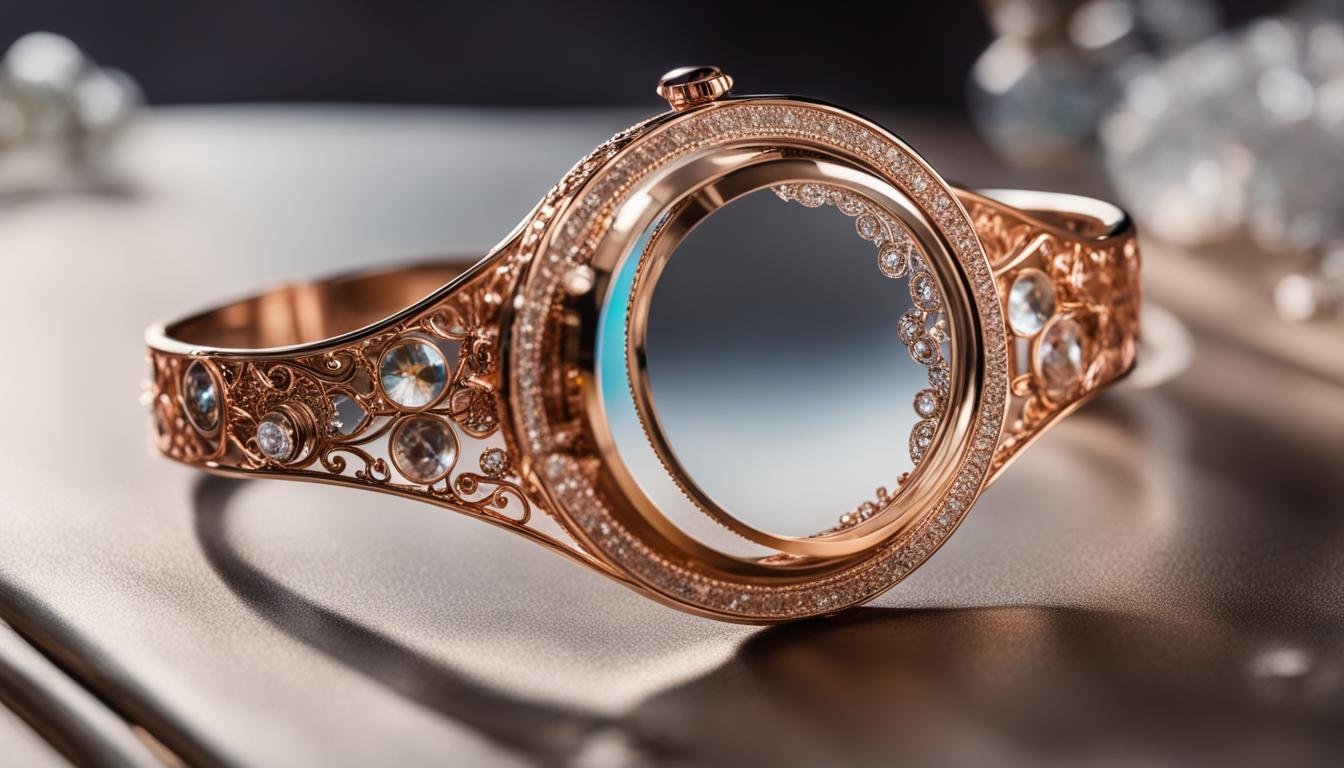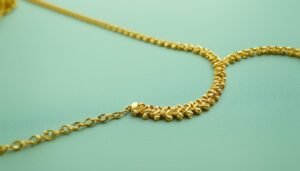Discover How Can You Tell if Rose Gold is Real?
Rose gold has become a popular choice in the world of jewelry, thanks to its unique and elegant pinkish hue. However, with the rise in popularity, the market has also seen an increase in fake rose gold pieces. Determining the authenticity of your rose gold jewelry is crucial to ensure that you are getting what you paid for. In this comprehensive guide, we will provide you with the essential information and tests to help you determine if your rose gold jewelry is real or not.
Before we dive into the authenticity tests, let’s start with the basics of rose gold. Understanding the composition and characteristics of rose gold is essential in distinguishing between real and fake pieces. From there, we will explore various methods to test the authenticity of your rose gold jewelry, including visual inspection, hallmark examination, and specific tests designed for accurate results.
Key Takeaways
- Understanding the composition and characteristics of rose gold is crucial in determining its authenticity.
- Visual inspection and hallmark examination are initial steps to assess the genuineness of rose gold jewelry.
- Specific tests like the water test, rusting test, magnetism test, scratch test, density test, and nitric acid test provide further accuracy in determining authenticity.
- Proper care is essential to maintain the beauty and value of your rose gold jewelry.
- Consider the pros and cons of rose gold before making a purchase decision.
Understanding Rose Gold and its Composition
Rose gold is a unique and popular choice in jewelry, known for its warm and romantic pinkish hue. To truly understand rose gold and determine its authenticity, it’s essential to familiarize yourself with its composition. Unlike pure gold, which is soft and yellow, rose gold is an alloy made by combining gold with other metals such as copper and sometimes silver.
The inclusion of copper in rose gold is what gives it its characteristic blush color. The more copper in the alloy, the deeper the pinkish hue. On the other hand, the gold content in rose gold determines its karat value, which indicates the purity of the gold used. Common karat ratings for rose gold jewelry range from 10K to 24K, with 24K being the purest form.
“Rose gold is not pure gold but an alloy made by combining gold with copper and sometimes silver. The inclusion of copper gives rose gold its distinctive pinkish hue, while the gold content determines its karat value.”
Understanding the Role of Copper and Silver in Rose Gold
Copper, as mentioned earlier, is the primary metal used to create the unique color of rose gold. The higher the copper content in the alloy, the redder the hue of the gold. However, too much copper can also make the metal more prone to tarnishing. Silver is occasionally added to rose gold alloys to enhance its durability and prevent tarnishing, while also contributing to its overall aesthetic appeal.
| Metal | Role |
|---|---|
| Copper | Provides the distinctive pinkish hue |
| Silver | Enhances durability and prevents tarnishing |
Understanding the composition of rose gold is crucial because it allows you to differentiate between real and fake pieces. Counterfeit rose gold jewelry often contains lower-quality metals or synthetic materials that mimic the appearance of rose gold. By examining the color, karat rating, and the presence of copper and silver, you can discern the authenticity of your rose gold jewelry and make informed purchasing decisions.
Decoding Rose Gold Hallmarks and Markings
When it comes to determining the authenticity of your rose gold jewelry, one important aspect to consider is the presence of hallmarks and markings. These engravings provide valuable information about the purity and composition of the piece. By understanding and deciphering these hallmarks, you can gain insight into the authenticity of your rose gold jewelry.
Many authentic rose gold pieces will feature specific hallmarks that indicate their purity. One common hallmark to look for is the karatage mark, which is typically represented by the letter K followed by a number. This number represents the gold content in the jewelry and can range from 10K to 24K. The higher the number, the higher the gold content and the purer the rose gold.
In addition to the karatage mark, you might also find other engravings and markings on your rose gold jewelry. These can include the manufacturer’s mark or logo, the country of origin, or even a quality control stamp. These markings vary depending on the piece and can provide further evidence of the authenticity and quality of your rose gold jewelry.
It’s important to note that while hallmarks and markings can be a valuable indicator of authenticity, they are not foolproof. Some fake or plated rose gold jewelry may also feature engravings to deceive buyers. That’s why it’s crucial to examine other factors, such as visual inspection and conducting additional tests, to confirm the authenticity of your rose gold jewelry.
To provide a clear overview, let’s summarize the key points about decoding rose gold hallmarks and markings:
- Authentic rose gold jewelry will have specific hallmarks and markings that indicate its purity.
- The karatage mark, usually represented by the letter K followed by a number, is a common hallmark to look for.
- Other engravings and markings, such as the manufacturer’s mark or quality control stamp, can provide further evidence of authenticity.
- While hallmarks and markings are important, they should be analyzed in conjunction with visual inspection and additional tests to confirm the authenticity of your rose gold jewelry.
| Hallmark | Meaning |
|---|---|
| Karatage Mark | Indicates the gold content in the jewelry, ranging from 10K to 24K. |
| Manufacturer’s Mark | Identifies the maker or company responsible for the jewelry. |
| Quality Control Stamp | Confirms that the piece has met specific quality standards. |
By paying careful attention to these hallmarks and markings and examining them alongside other indicators of authenticity, you can confidently determine if your rose gold jewelry is the real deal.
Visual Inspection and Hallmark Examination
To determine the authenticity of your rose gold jewelry, a visual inspection and hallmark examination are essential. These simple yet effective methods can provide valuable clues about the genuineness of your piece. Start by carefully examining the jewelry, paying close attention to any hallmark engravings. Look for the karatage mark, typically located on the clasp or inner bands of the piece.
If necessary, use a magnifying glass to get a closer look at the hallmark and check for any inconsistencies or signs of plating. Genuine rose gold will have a clear and precise hallmark that indicates its purity. Look for the karatage number, usually accompanied by the letter “K”. For example, “14K” signifies 14-karat rose gold.
During the visual inspection, also observe the overall appearance of the jewelry. Authentic rose gold has a warm and rich pinkish hue, while fake or plated pieces may exhibit a different shade or uneven color distribution. Take note of any discolorations or spots where the rose gold may have worn off, as these areas can provide important clues about the authenticity of the piece.
| Visual Inspection and Hallmark Examination Checklist |
|---|
| Inspect the hallmark for karatage and consistency |
| Use a magnifying glass to check for plating or inconsistencies |
| Observe the overall color and appearance of the jewelry |
| Take note of any discolorations or areas where the gold has worn off |
By conducting a thorough visual inspection and hallmark examination, you can gather important information about the authenticity of your rose gold jewelry. However, it’s important to note that these methods are not foolproof and may require additional tests and assessments to confirm the genuineness of your piece.

Key Points:
- Inspect the hallmark for karatage and consistency
- Use a magnifying glass to check for plating or inconsistencies
- Observe the overall color and appearance of the jewelry
- Take note of any discolorations or areas where the gold has worn off
Number Markings and Letter Markings
In addition to karatage marks, some rose gold jewelry may have number or letter markings. These markings can provide valuable information about the gold content and whether the piece is gold plated or gold electroplated. Understanding these markings is essential for determining the authenticity of your rose gold jewelry.
Number Markings: Number markings on rose gold jewelry often indicate the gold percentage in the piece. For example, a marking of “585” means the jewelry is 58.5% gold, which corresponds to 14 karat gold. Similarly, “750” indicates 75% gold or 18 karat gold. Familiarizing yourself with these number markings will help you determine the quality of the gold used in your jewelry.
Letter Markings: Letter markings on rose gold jewelry can indicate whether the piece is gold plated or gold electroplated. Common letter markings include “GP” for gold plated and “EP” for gold electroplated. These markings signify that the piece is not solid gold but rather has a thin layer of gold over a base metal. It’s important to note that gold-plated or gold-electroplated jewelry may eventually wear off, revealing the base metal underneath.
Examining the number and letter markings on your rose gold jewelry can give you valuable insights into its authenticity and quality. However, keep in mind that professional jewelers and appraisers are best equipped to accurately evaluate these markings and provide a definitive assessment of your jewelry’s authenticity.
| Marking | Meaning |
|---|---|
| 585 | 58.5% gold or 14 karat gold |
| 750 | 75% gold or 18 karat gold |
| GP | Gold plated |
| EP | Gold electroplated |
Color Discolorations and Skin Reactions
When examining your rose gold jewelry for authenticity, it’s important to pay attention to color discolorations and potential skin reactions. Color discolorations can occur in areas where the gold has worn off, revealing a different underlying metal. This can be an indication that your jewelry is not genuine rose gold, but instead, it may be plated or made from a different metal altogether.
Take a close look at any spots on your jewelry where the color appears different or faded. If you notice significant variations in the hue or areas where the pinkish hue has completely disappeared, it’s likely that your piece is not authentic rose gold. Additionally, be mindful of any skin reactions or discolorations that may occur when wearing your rose gold jewelry. Genuine rose gold should not cause any allergic reactions or irritation, so if you experience any discomfort, it’s possible that your piece is not authentic.
Remember, color discolorations and skin reactions are important factors to consider when determining the authenticity of your rose gold jewelry. By examining these aspects closely, you can make a more informed assessment of the genuineness of your piece.

Table: Summary of Color Discolorations and Skin Reactions
| Indicators | Possible Interpretation |
|---|---|
| Significant variations in color or faded spots | Possible indication of plated or non-genuine rose gold |
| Complete absence of pinkish hue | Likely not authentic rose gold |
| Skin reactions or discomfort | Possible indication of non-genuine or lower-quality metal |
Table: Summary of color discolorations and skin reactions, indicating possible interpretations based on observed indicators.
Testing Properties – Water Test, Rusting Test, Magnetism, and Scratch Test
When determining the authenticity of your rose gold jewelry, it’s important to conduct various tests to assess its properties. These tests can help you distinguish between real gold and plated or imitation gold. In this section, we will explore four commonly used tests: the water test, rusting test, magnetism test, and scratch test.
Water Test
The water test is a simple yet effective method to determine if your rose gold jewelry is real or fake. Start by filling a jug or container with water. Carefully drop your jewelry piece into the water and observe its behavior. If the jewelry sinks to the bottom, it is likely made of real gold. On the other hand, if it floats or remains near the surface, it may be plated or imitation gold.
Rusting Test
The rusting test involves assessing how rose gold reacts to moisture. Take a small piece of cotton or a cotton swab and dampen it with water. Gently rub the damp cotton against a hidden or inconspicuous area of your jewelry. If you notice any signs of rust or discoloration, it could indicate that the piece is not made of real gold. Genuine rose gold should not rust or tarnish when exposed to moisture.
Magnetism
Magnetism is another property that can help determine the authenticity of rose gold. Place a small magnet near your jewelry piece and observe if it attracts or repels. Real gold is not magnetic, so if your jewelry is attracted to the magnet, it is likely made of a different metal or plated with gold. However, keep in mind that this test is not foolproof, as some non-magnetic metals can be used for jewelry that resembles rose gold.
Scratch Test
The scratch test is a commonly used method to determine if your rose gold jewelry is authentic. Find an unglazed ceramic surface, such as the bottom of a porcelain plate, and gently rub your jewelry against it. Real gold will leave a gold streak on the ceramic, while fake gold may leave a black streak. However, exercise caution when performing this test, as it can potentially damage or scratch your jewelry.
| Test | Result |
|---|---|
| Water Test | Sinks (Real gold) Floats or near the surface (Plated or imitation gold) |
| Rusting Test | No rust or discoloration (Real gold) Rust or discoloration (Not real gold) |
| Magnetism | Not attracted to the magnet (Real gold) Attracted to the magnet (Not real gold) |
| Scratch Test | Leaves a gold streak (Real gold) Leaves a black streak (Not real gold) |
By conducting these tests, you can gain a better understanding of the properties of your rose gold jewelry and determine its authenticity. However, it’s important to note that these tests are not definitive proof and should be used in conjunction with other methods, such as visual inspection and hallmark examination, to make a more accurate assessment.
Density Test for Authenticity
To determine if your rose gold jewelry is real, you can conduct a density test. This test involves weighing the piece and measuring the displacement of water when it is dropped into a graduated cylinder. By comparing the resulting density with the known density of real gold, you can assess the authenticity of your jewelry.
To perform the density test, follow these steps:
- Weigh the rose gold jewelry using a reliable scale. Make sure to record the weight.
- Fill a graduated cylinder with a precise amount of water.
- Drop the rose gold jewelry into the graduated cylinder.
- Measure the change in volume caused by the displacement of water.
- Calculate the density by dividing the weight of the gold by the change in volume.
- Compare the calculated density with the known density of real gold.
If the calculated density is close to the known density of real gold, there is a higher likelihood that your rose gold jewelry is authentic. However, it’s important to note that this test may not be conclusive on its own and should be used in conjunction with other authenticity tests.
| Known Density of Real Gold | Calculated Density of Rose Gold | Conclusion |
|---|---|---|
| 19.3 g/cm3 | 19.1 g/cm3 | Higher likelihood of authenticity |
Remember, conducting a density test requires accuracy and precision. If you’re unsure or want a more accurate assessment, consult a professional jeweler or invest in a gold testing kit that includes specialized acids for purity measurement.
Nitric Acid Test for Precise Purity Measurement
When it comes to determining the exact purity of your rose gold jewelry, the nitric acid test is a reliable method that provides precise results. This test requires a gold testing kit that uses specific acids to assess the gold percentage of your piece. By following the instructions provided with the testing kit, you can perform the nitric acid test to determine the authenticity of your rose gold jewelry.
“The nitric acid test is commonly used by professionals in the jewelry industry to accurately measure the gold content of a piece,” explains expert jeweler, Sarah Thompson. “It’s important to exercise caution when performing this test as it involves the use of corrosive acids.”
To conduct the nitric acid test, you’ll need to scratch the protected areas of your jewelry, typically on the inner band or clasp. This allows the acid to react with the metal and determine its purity. Remember to wear protective gloves and eyewear while performing the test and ensure proper ventilation in your workspace.
Once you have scratched the piece, carefully apply a drop of the nitric acid solution included in the testing kit to the exposed area. Observe the reaction carefully; genuine rose gold will show little to no change in color, while fake gold may turn a greenish color due to the presence of copper or other base metals.

Common Results and Interpretation:
| Observation | Purity Assessment |
|---|---|
| No Color Change | High-quality rose gold |
| Light Green or Milky Color | Low karat rose gold (less gold content) |
| Green Color | Gold-plated or gold-filled jewelry |
| Red or Brown Color | Base metal or non-gold alloy |
Always refer to the instructions provided with your specific gold testing kit for accurate interpretation of the results. If you’re unsure about performing the test yourself or interpreting the results, it’s best to consult a professional jeweler who can assist you in determining the purity of your rose gold jewelry.
Tips for Caring for Rose Gold Jewelry
Now that you have determined the authenticity of your rose gold jewelry, it is important to know how to care for it properly. By following these tips, you can prevent damage and keep your rose gold jewelry looking beautiful for years to come.
Preventing Damage
- Avoid exposing your rose gold jewelry to harsh chemicals such as bleach, chlorine, or cleaning agents. These can cause discoloration or damage to the metal.
- Remove your rose gold jewelry before engaging in activities that may result in scratches or impact, such as sports or heavy-duty tasks.
- Store your rose gold jewelry in a separate compartment or pouch to prevent it from getting scratched or tangled with other pieces.
Cleaning Tips
To clean your rose gold jewelry, follow these simple steps:
- Fill a bowl with warm water and add a small amount of mild dish soap.
- Place your rose gold jewelry in the soapy water and let it soak for a few minutes.
- Gently scrub the jewelry with a soft-bristled toothbrush or a cloth.
- Rinse the jewelry under warm running water to remove any soap residue.
- Pat dry with a clean, soft cloth.
It is important to note that you should not use abrasive materials or harsh chemicals when cleaning your rose gold jewelry, as this can cause damage to the metal.
By following these tips for caring for your rose gold jewelry, you can ensure that it remains in excellent condition and continues to shine for years to come.

Pros and Cons of Rose Gold
Rose gold jewelry has gained significant popularity in recent years, thanks to its unique and fashionable appearance. But like any other metal, rose gold has its pros and cons. Understanding these benefits and drawbacks can help you make an informed decision when purchasing or wearing rose gold jewelry.
The Pros of Rose Gold
- Elegant and Fashionable: Rose gold has a warm, romantic hue that adds a touch of elegance to any piece of jewelry. Its soft pink color exudes femininity and complements a wide range of skin tones.
- Versatility: Rose gold is incredibly versatile, making it suitable for various styles and occasions. Whether you prefer a delicate necklace or a bold statement ring, rose gold can effortlessly elevate your look.
- Durability: Rose gold’s alloy composition, particularly the inclusion of copper, enhances its durability and makes it more resistant to scratches and dents compared to other precious metals like yellow gold.
The Cons of Rose Gold
- Potential Allergic Reactions: While rose gold is generally hypoallergenic, some individuals with sensitive skin may experience allergic reactions. If you have a known sensitivity to copper or other metals in the alloy, it’s essential to take precautions or consider alternative metals.
- Color Fading: Over time, the pinkish hue of rose gold may fade due to exposure to chemicals, natural body oils, and everyday wear. Periodic re-plating may be required to restore its original color and luster.
- Higher Price: Rose gold’s rising popularity has led to an increase in its demand and, subsequently, its price. Compared to other metals like silver or stainless steel, rose gold jewelry can be more expensive.
In conclusion, rose gold jewelry offers a unique and fashionable option for those seeking a warm and romantic look. Its elegance, versatility, and durability make it a desirable choice. However, it’s important to consider potential allergic reactions, the possibility of color fading, and the higher price associated with rose gold. Ultimately, the decision to wear or purchase rose gold jewelry is a personal one, based on individual preferences and budget.

Conclusion
Determining the authenticity of your rose gold jewelry is crucial to ensure that you have a genuine piece. By following the methods outlined in this guide, you can confidently assess the purity of your rose gold and make informed decisions. Remember, there are several factors to consider when determining rose gold authenticity, including visual inspection, hallmark examination, and various tests.
Performing a visual inspection and examining the hallmark can provide initial clues about the authenticity of your rose gold jewelry. Look for karatage marks and pay attention to any inconsistencies or signs of plating. Additionally, familiarize yourself with number and letter markings commonly found on rose gold jewelry to make accurate assessments.
Conducting tests such as the water test, rusting test, magnetism test, scratch test, and density test can further help in determining the authenticity of your rose gold jewelry. These tests assess different properties of the metal and provide valuable insights. Be sure to exercise caution and follow instructions carefully, especially when conducting the nitric acid test, as it can be destructive if not performed correctly.
Once you have determined the authenticity of your rose gold jewelry, remember to care for it properly to maintain its beauty and value. Avoid exposing it to harsh chemicals, and regularly clean it using mild soapy water and a soft cloth. By following these guidelines, you can enjoy your genuine rose gold jewelry for years to come.
FAQ about How Can You Tell if Rose Gold is Real
How can I determine if my rose gold jewelry is real?
There are several methods you can use to determine the authenticity of your rose gold jewelry, including visual inspection, hallmark examination, and various tests such as the water test, rusting test, magnetism test, scratch test, density test, and nitric acid test.
What is rose gold made of?
Rose gold is an alloy made by combining gold with copper and sometimes silver. The inclusion of copper gives rose gold its distinctive pinkish hue, while the gold content determines its karat value.
What should I look for in the hallmarks and markings of rose gold jewelry?
Authentic rose gold jewelry will have specific hallmarks and markings that indicate its purity. Look for the karatage mark, usually located on the clasp or inner bands of the piece. Pay attention to any number or letter markings that may indicate the gold percentage or if the piece is gold plated or gold electroplated.
How can I visually inspect my rose gold jewelry?
Conduct a visual inspection by examining the hallmark on your rose gold jewelry. Look for any inconsistencies or signs of plating. Use a magnifying glass if necessary to identify the hallmark and check for any engravings or markings.
What do color discolorations on rose gold jewelry indicate?
Color discolorations, particularly in areas where the gold has worn off, can indicate if your rose gold jewelry is real or plated. Examine these spots closely and look out for any noticeable changes in color. Also, pay attention to any skin reactions or discolorations that may occur when wearing your rose gold jewelry.
What tests can I conduct to assess the authenticity of rose gold?
Several tests can be conducted, including the water test, rusting test, magnetism test, and scratch test. These tests examine the properties of rose gold to determine its authenticity. The density test and nitric acid test are more accurate methods of assessing the purity of your rose gold jewelry.
How does the density test determine the authenticity of rose gold?
The density test involves weighing the piece of rose gold jewelry, filling a graduated cylinder with water, and measuring the displacement when the gold is dropped in. The resulting density can be compared to the known density of real gold to determine authenticity.
What is the nitric acid test for rose gold?
The nitric acid test is a reliable method to determine the exact purity of your rose gold jewelry. This test requires a gold testing kit that uses specific acids to assess the gold percentage. You’ll need to scratch the protected areas of the jewelry and follow the instructions provided with the testing kit.
How should I care for my rose gold jewelry?
To maintain the beauty and durability of your rose gold jewelry, avoid exposing it to harsh chemicals and clean it regularly using mild soapy water and a soft cloth.
What are the pros and cons of rose gold?
Rose gold has a unique and fashionable appearance, is versatile, and durable. However, it may cause allergic reactions for sensitive individuals, and periodic re-plating may be required if the piece loses its color.








